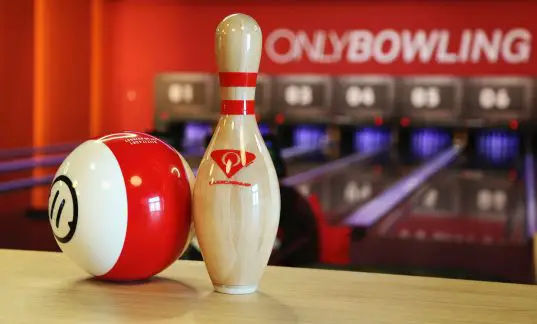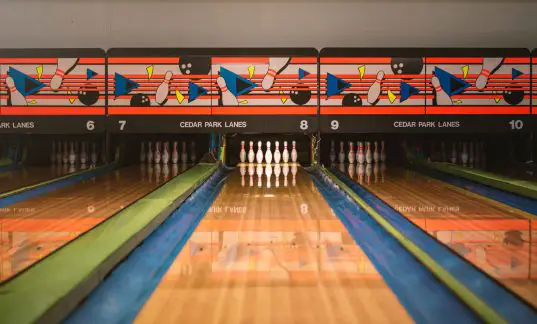If you’re a ten-pin bowling enthusiast, it’s likely safe to say that you know your way around a bowling lane. You can probably call out a pin number on instinct, curse the head pin for wobbling and staying up, and turn house bowling balls into scoresheet magic. However, have you really gotten to know the ten pins down the lane?
Like, have you really studied a pin deck? You may watch a machine set up bowling pins over and over again, but do you know the particulars of the arrangement such as the required shape and spacing?
When ten bowling pins are set, magic tends to happen. So, why not learn more all the pins and outs (get it? we’re funny!) of tenpin bowling? We’ll show you what a proper bowling pin set is at your local bowling alley and what it should look like from your first-row vantage point behind the foul line.
Bowling Pin Setup (Arrangement, Spacing, Numbering)
How many pins are there in a set?
There are ten pins in a traditional bowling pins set. The first row is one pin. The second round has two pins. The third row has three pins. And the fourth and final row has four pins.
How are bowling pins numbered?
While bowling pins (usually) don’t have large numbers that are easy to see when they come down from the pin rack, each of the pins have a unique number based upon their placement in each pin spot. Pins knocked down on a non-strike shot are counted as points. The remaining pins are usually called out by their number. For example, a bowler might get mad that the 7 pin always stays up when they hit the pocket flush. Other bowlers might get hot under the collar when a 7-10 split rears its ugly head.
When you bowl, it pays to know the numbers of the pins in their particular rows! That way, you can have fun talking about the sport in the parlance of other bowlers.
So, how are bowling pins numbered exactly? It depends on where they are arranged!
The pin in the first row (and the pin closest to a bowler) is called the head pin, or 1 pin.
From left to right from a bowler’s perspective, the second row contains the 2 and 3 pins.
From left to right in the third row, the 4, 5, and 6 pins make their homes.
And finally, the 7, 8, 9, and 10 pins are in the back row, or fourth row.
What shape do pins make when they are set up?
When properly placed from frame to frame, the ten pins on a bowling lane form an equilateral triangle formation. The ten pins are evenly spaced in their four rows, putting the onus on you and your bowling ball to knock them down with skill and power.
The triangular formation at the end of the bowling lane is the perfect shape for controlled bowling chaos. That’s part of what makes the game so dang fun!
How far apart are bowling pins spaced?
In each row, pins are spaced 12 inches apart from one another. There’s a distance of 20.75 inches between pins in adjacent rows. And, the length of an equilateral triangle bowling pin set should be 36 inches exactly. If one pin is off-center and the rack is shaped a bit off, it will be much harder to pick up strikes with a proper pocket hit. Make sure you observe the pins on the first ball of your first game, letting the bowling alley operator know if there are any issues.
How do bowling alleys reset pins?
Before the advent of automated bowling pinsetters, young men or boys known as pin boys were trained to manually set pins with the proper spacing, length, and width.
Now, automated pinsetters do the work! After a shot is thrown, a sweep bar removes all fallen pins and other pins left on the lane from previous shots. The pins are swept into the pit to be sorted for resetting. These pins are placed into pin storage and sent up to the table for placement ten at a time with the help of a pin elevator.
We’ll go more into the terminology used above in just a moment, but the hope of this section is to show you how an automated pinsetter should work when in full operation. If errant pins are continuously left on the lane or a particular bowling pin set looks flawed, contact the bowling alley operator for immediate assistance.
The Terminology Of Bowling Pins
We used some key bowling pin terms in the sections above that you may not be familiar with, so we’ve created this handy-dandy section to give you the lowdown on some of the key pin-related terms you should be familiar with.
Ball Return
The mechanism where balls are returned to the approach area for use.
Dead Wood
Pins that aren’t part of the current set, left in the middle of the lane by an errant sweep bar.
Deck
For Brunswick A Series pin-setting machines, a deck is a metal enclosure that protects each side of a pin table from errant throws and potential damage.
Head Pin
The 1 pin, or the only pin in the first row.
Pin Deck
Different from a deck, the pin deck is where the pins are placed on a bowling lane.
Pin Elevator
The mechanism that pulls pins out of the pit to be stored for future use.
Pin Spot
The circular spot where a pin is placed on a pin deck.
Pin Storage
The storage area where full racks of pins are held before being placed back on the lane.
Pin Turret
A pin storage system unique to Brunswick A Series pin-setting systems.
Pit
Where pins are collected after being swept off the lane with a sweep bar.
Re-Rack
Resetting pins to ensure proper placement on the pin deck.
Scoring Sensor
Floor sensors that send information to the scoring system when a pin is knocked down.
Sweep Bar
The mechanism that sweeps fallen pins off the lane and into the pit for sorting.
Table
The mechanism that places the pins on the pin deck in an equilateral triangular formation.
Frequently Asked Questions
What board is a 6 pin on in bowling?
From the right to left of bowlers at the foul line, the 6 pin is placed on the 5 board of a bowling lane.
How much do bowling pins weigh?
Standard bowling pins weigh 3 pounds, 8 ounces with an allowed variance of 2 ounces, per current USBC specifications. Bowling pins are also 15 inches high and measure 4.75 inches wide at the thickest point of the pin.
How many feet from the foul line are bowling pins set?
The front of the pin deck is 60 feet away from the foul line on a bowling lane. For comparison’s sake, a pitcher’s mound is 60 feet, 6 inches away from home plate in Major League Baseball.
Why do bowling pins have holes in the bottom?
Bowling pins have holes on their bottoms for two distinct reasons — for weight reduction to meet USBC and/or league standards, and as a reference point for manufacturers to center the pin properly in a mold during the coating process.
Final Thoughts
Learning about bowling pin setups might not be the ticket to higher scores overall. But, it will give you an understanding of what you’re up against exactly every time you step up to the foul like. Now that you know everything there is to know about bowling pins, it’s time to knock them down with confidence. Good luck and best wishes at the lanes!


